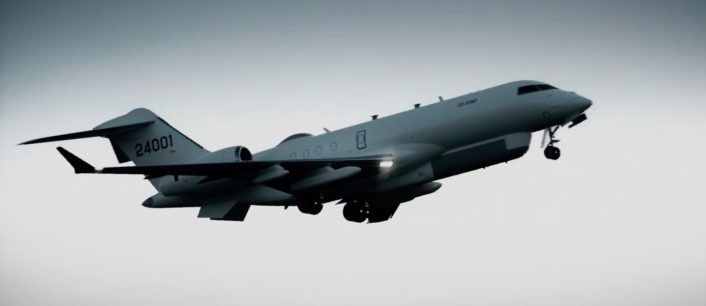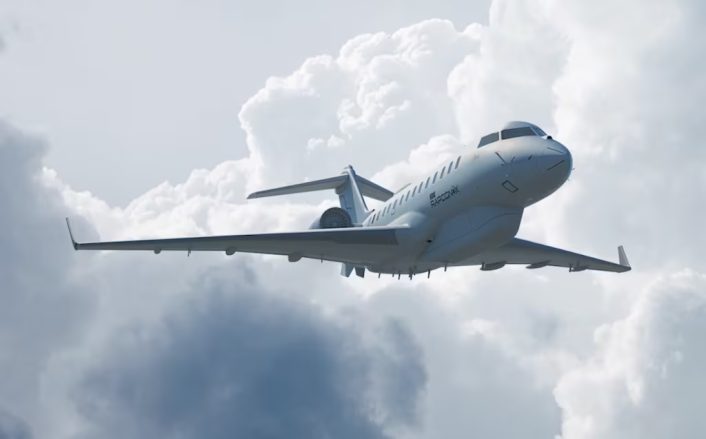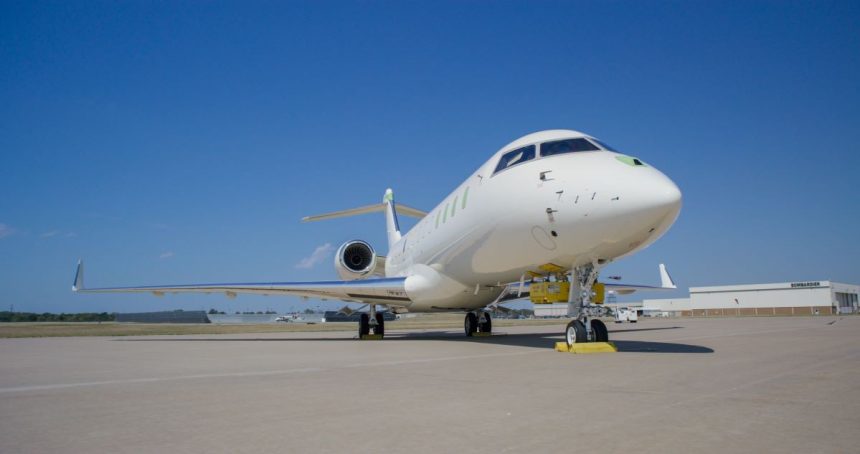The Global 6500 business jet will integrate deep sensing technologies to perform ISR missions as the U.S. Army is looking to replace its legacy turboprop ISR fleet with the new HADES.
Bombardier Defense has announced the delivery of the first Bombardier Global 6500 aircraft in support of the U.S. Army’s High Accuracy Detection and Exploitation System (HADES) program during a ceremony held at the company’s facilities in Wichita, Kansas. The airframe will become the prototype of the next-gen intelligence, surveillance and reconnaissance (ISR) and will soon advance to the system integration phase.
Sierra Nevada Corporation, which won the contract as lead system integrator in August 2024, will incorporate deep sensing technologies on the business jet as part of its transformation into an ISR platform. The new platform will provide the Army with an aircraft able to perform its mission at higher altitudes and speed, longer ranges and durations and with a greater payload.
Aujourd’hui, #BombardierDefense a livré la première plateforme #Global6500 à @USArmy pour le programme #HADES.
Nous faisons progresser les capacités de #ISR aériennes de prochaine génération avec une portée, une vitesse et une fiabilité inégalées. @ISRTaskForce pic.twitter.com/SP3ePle5Ae
— Bombardier (@Bombardier) November 25, 2024
“Bombardier Defense is honored to support the U.S. Army with the delivery of the first Global 6500 aircraft, a high-performance platform that possesses the speed, endurance-at-range and altitude capabilities to support deep-sensing for the Army of tomorrow,” said Steve Patrick, Vice President of Bombardier Defense. “This best-in-class jet is the future-proofed solution to provide the U.S. Army with the capabilities needed to face current and future threats.”
The Global 6500 provides several advantages, such as reliability, operational reach, and expanded operating areas. Bombardier mentions, specifically, a maximum endurance of up to 18 hours, and up to 750 flight hours between maintenance intervals, which allow the Global family to have an impressive 99.83% dispatch reliability.
“HADES is the centerpiece of the Army’s collection strategy, and the Global 6500 is the system that brings that strategy to life,” said Andrew Evans, Director, HQDA G-2 ISR Task Force. “This aircraft gives us the range, payload capacity, speed and endurance to deliver timely, relevant and responsive capabilities for the full spectrum of Army and Joint collection requirements.”
The start of the integration phase is currently on hold, following the protest from L3Harris, the other contender for HADES. L3Harris filed a formal protest on Sep. 16, asking the Government Accountability Office (GAO) to review the decision. Until the GAO announces a decision, the work will be on stand-by.

The Global 6500
The Global 6500 is one of the components of the broader Bombardier Global Express family, a large cabin, long-range business jet family which first flew in 1996. The Global 6500 was unveiled in 2018 as a longer-range variant of the Global 6000, itself an improved variant of the original design.
The Global 6500 has upgraded Rolls-Royce BR710 Pearl engines, with up to 13% lower fuel burn for better operating costs and 9% more thrust. Also, the aircraft has better hot and high performance compared to the Global 6000 and 600 NM of additional range.
Before the U.S. Army selected the Global 6500 for HADES in December 2023, the Global Express family was already used for multiple military conversions. In fact, the Global 6000 is the base for the Saab GlobalEye Airborne Early Warning and Control (AEW&C) aircraft, the E-11 Battlefield Airborne Communication Node (BACN) and the Pegasus signal intelligence (SIGINT) aircraft, just to mention some.
The same aircraft was chosen also for the ongoing Army Theater Level High-Altitude Expeditionary Next Aerial-Radar/Signals Intelligence (ATHENA-R/S) programs, as well as HADES. The adoption of a commercial derivative aircraft not only offers the reliability and endurance of the Bombardier Global 6500 airframe, but also a higher supportability and deployability due to its global support network.

HADES
The High Accuracy Detection and Exploitation System (HADES) program is a major step in the U.S. Army’s plans to modernize its fixed-wing manned ISR (Intelligence, Surveillance and Reconnaissance) fleet. The service has long recognized that its existing fleet of turboprop aircraft is not adequate to meet requirements for the multi-domain operations against peer and near-peer adversaries.
To replace these systems, the Army decided to pursue the Multi-Domain Sensing System (MDSS) HADES program which will provide the Army with an aircraft able to perform its mission at higher altitudes and speed, longer ranges and durations and with a greater payload.
The Army began shaping the HADES program in 2020 to replace the legacy turboprop aircraft fleet currently comprised of the RC-12X Guardrail, MC-12S Enhanced Medium Altitude Reconnaissance and Surveillance System, and EO-5C Airborne Reconnaissance Low aircraft, which have been in service for more than four decades. HADES prototypes will be the first Army-owned large-cabin business jets utilized for aerial ISR platforms.
The goal of HADES is to provide the service with a fleet of ISR aircraft with SIGINT (signal intelligence), SAR/MTI (synthetic aperture radar/moving target indicator) and additional capabilities. The aircraft is intended to rapidly gain and maintain situational understanding, freedom of maneuver, information overmatch, and decision advantage thanks to the ability to be globally deployable and operate outside the range of enemy anti-access/area denial systems.
In preparation for HADES, the Army demonstrated and deployed operationally ISR jets as part of the contractor-owned and operated Airborne Reconnaissance and Targeting Multi-Mission System (ARTEMIS) and Aerial Reconnaissance and Electronic Warfare System (ARES) programs. These allowed to evaluate sensors and collect data at the altitudes, speed, and ranges that HADES is expected to perform in order to help inform the program’s requirements.
The key feature of HADES is the integration of deep sensing to perform the ISR mission. The Army Field Manual (FM) 2-0: Intelligence defines deep sensing as “the employment of capabilities beyond the division coordinated firing line to collect data and information that supports targeting, situational understanding, or decision making.”
The specifics of this deep sensing capability are not known, but the service says it will drastically improve its intelligence gathering capabilities in multi-domain operations. In a press release, SNC said that many of its signature design and integration capabilities, to include Artificial Intelligence and Machine Learning, are incorporated into the HADES system, empowering mission processing, exploitation and dissemination to more quickly facilitate all-domain awareness.
SNC recently announced the first flight of the Global 6500 converted to the Rapidly Configurable To Any Mission-X (RAPCON-X) configuration as part of the ATHENA-S contract. According to Josh Walsh, SNC vice president of mission solutions and operations, the company plans to reuse “about 90 percent” of the ATHENA-S engineering package for HADES.









